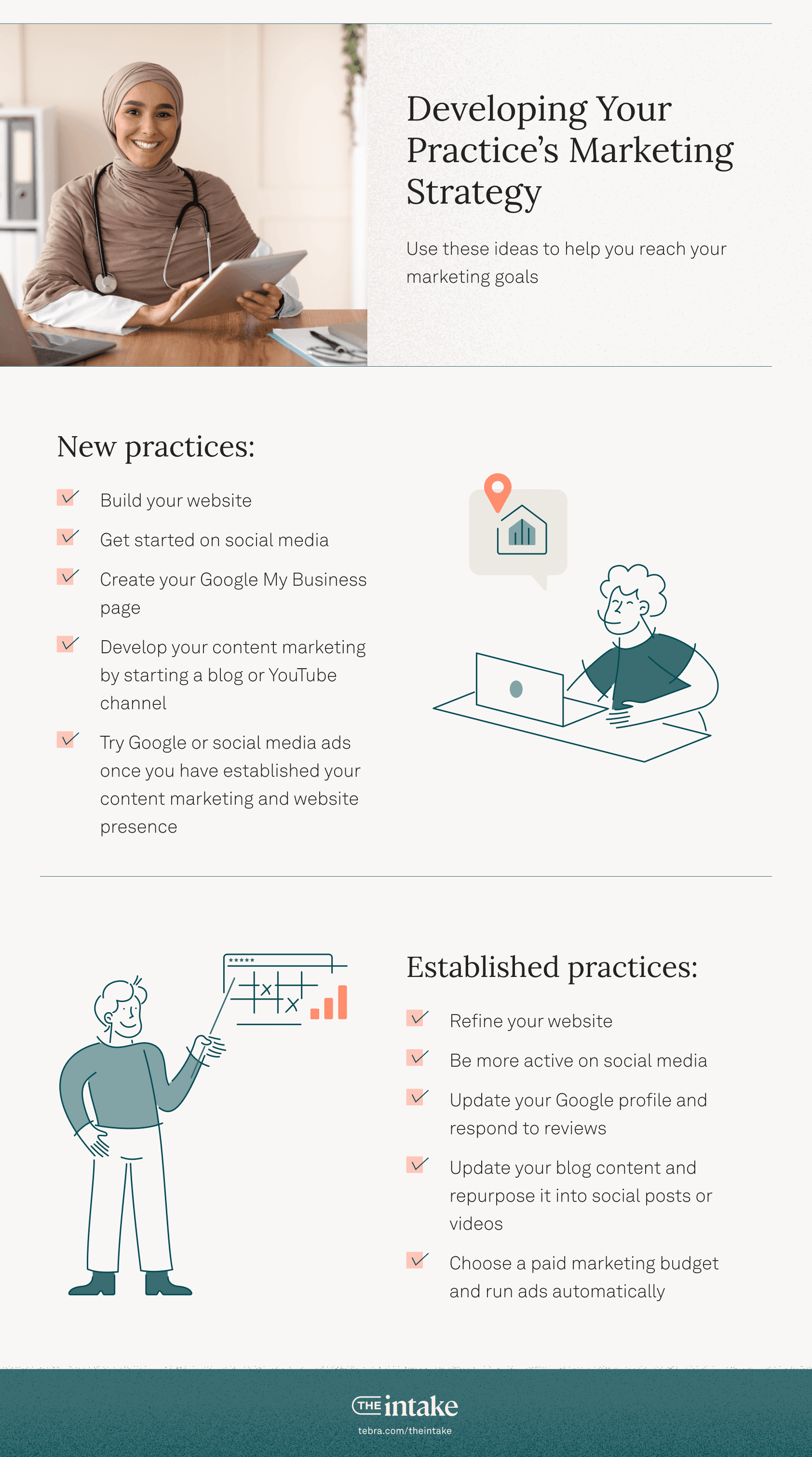Borrow this medical practice marketing plan template
This medical practice marketing plan template makes it easier than ever to ensure your healthcare marketing is off to a good start.

Most Popular
At a Glance
- Having a strong marketing plan is essential for medical practices to retain existing patients and attract new ones in an increasingly competitive healthcare landscape.
- The marketing plan template here includes researching your specialty, setting measurable goals, developing online assets, using SEO and paid ads, and tracking metrics.
- This template emphasizes understanding patient perspectives and building patient satisfaction through your website, brand messaging, administrative processes, and content creation. Satisfied patients can generate referrals over time.
When it comes to healthcare marketing, it can feel like trying to do everything at once. Social media, local SEO, websites, blogging — where to start? If you have started digital marketing, optimizing your marketing efforts and identifying strategies for growth can be just as elusive — which is where this medical practice marketing plan template comes in.
Yet, having a healthcare marketing plan has never been more important. According to Tebra’s Patient Perspectives report, 29% of patients have left a practice over the last 2 years.
The good news is that there are many techniques you can use in your healthcare marketing strategy to retain and acquire new patients.
In this medical practice marketing plan template, we’ll cover everything you need to know to jumpstart your initiatives. This includes setting marketing goals, figuring out a budget, and potential strategies for both new and established practices.
The ultimate medical practice marketing plan template
Whether you have a new, mid-sized, or established practice, this marketing plan has something for you.
The best way to use this template is to read through the following steps and jot down your ideas. You’ll likely be able to fit your marketing plan onto 2 or 3 sheets of paper.
In short, you’ll want to:
- Research your specialization
- Set your goals
- Define “success” with metrics
- Decide on a budget
- Select strategies
- Review your progress regularly

Research your niche
Before you do anything, it helps to see what the competition and industry are doing as a whole. You’ll also want to find out what patients expect.
Specifically, you’ll want to take note of what:
- Website standards looks like — how many pages do you need, what kind of information is required
- Social platforms your competition uses
- Kind of content they create, if any
- Content they don’t create
Set your goals
Like with any other endeavor, the first thing you’ll want to do after researching is establish a set of goals. Ideally, you’ll want no more than 1 or 2 goals for a specific time period, such as a month or quarter.
You’ll also want to be realistic about what you can accomplish — going viral or getting on the first page of Google in 3 months isn’t impossible, but it is unlikely, especially for a new site.
Some common objectives are:
New practices |
|
Established practices |
|
Once you have your main goal(s), it’s time to break them down into smaller tasks. For example, if you need to create a website:
- Select a hosting provider
- Install a theme
- Create website pages for About, Services, Contact, and Testimonials
- Use HIPAA-compliant scheduling integrations
- Install Google Analytics tracking to check your progress
Decide how to measure results
Next, assign clear measurements for each goal. For items like “build a website,” it can be as simple as ensuring you meet all the standards for your industry. But for items that revolve around improving SEO, figuring out if high-quality resources work or another ongoing effort, specific metrics help track progress.
“A survey for current or new patients to complete will give you more information about how they found your practice, their experience, and their overall patient satisfaction score.”
Some common metrics to track are how:
- Much website traffic you get to gauge SEO traction
- Long people are staying on your website or a specific page
- Many people schedule an appointment
- Many people follow up from the website form
A survey for current or new patients to complete will give you more information about how they found your practice, their experience, and their overall patient satisfaction score.
Finalize a budget
Once you decide what you need to get done and how you’ll measure success, decide on a budget. Before spending a cent, you should review the average service costs, including working with a marketing agency or freelancer. Having a set price in mind will make it easier to shift through the options — because there are many.
So, what’s the golden number? A general rule of thumb is to set aside 5-10% of your revenue for marketing initiatives. Once you determine your quarterly or annual priorities, you can divvy up this amount per task.
Keep in mind, if you have a new practice, you will likely spend most of your marketing budget on creating one-off items, such as your website, branding, and custom photography. After these items are done, you can focus on expanding your spend to growth-based activities, like content marketing or ads.
Potential marketing strategies
Now that you have goals and a budget, where should you start? There are some common and effective strategies for new and established practices alike.
New practices
New medical practices tend to have a shoestring marketing budget with a huge list of priorities. Focus on a few core competencies and build your platform up over time. A firm foundation is key to success in the long term, so it’s okay to take your time. Results may not be immediate but will snowball over time.
So, what strategies make sense? Here’s a mega-list of marketing strategies broken up into bite-sized tasks.
Build your website |
|
Get started on social media |
|
Google Business Profile |
|
Content marketing |
|
Paid marketing |
|
Established practices
Refine your website |
|
Do more on social media |
|
Google Business Profile |
|
Ramp up content marketing |
|
Paid marketing |
|

3 more tips for medical practice marketing success
In addition to this medical practice marketing plan template, consider a few other items for long-term success:
- Patient satisfaction: Happy patients generate referrals. Making it easier for patients to book appointments, review results, upload their documentation, and pay the bill can all contribute to patient satisfaction.
- Brand awareness: Your brand is the way that patients recognize you. In the beginning, it may be difficult to spend money on creating a cohesive brand image. But doing so can be a useful investment. Spending time reflecting on how you want to present yourself and your practice can make the entire marketing process more efficient — and ensure you are reaching the right people.
- Leverage technology: Back-office technology, whether for marketing, billing, or administration, can reduce your workload. Take advantage of these solutions so you don’t have to shoulder everything yourself. And when you do hire an employee, freelancer, or agency for your marketing or billing, it’ll be easier for them to work effectively, too.
Overall, remember that you’re playing the long game. Marketing can take time to make a difference, but if built correctly, it can sustain your career and serve your patients.
What patients want
Part of a successful marketing plan is figuring out what patients expect and want from their healthcare professional. Then you can integrate these expectations into your website and social media messaging.
“Marketing can take time to make a difference, but if built correctly, it can sustain your career and serve your patients.”
So, where can you tap into the insight from this medical practice marketing plan template? You could look through practice reviews from the competitors and see what’s lacking. It’s also possible to make a list of potential improvements from current patients. Or you can review Tebra’s Patient Perspectives report for more in-depth data.
You Might Also Be Interested In
How patients find and pick their doctors. We surveyed more than 1,200 patients nationwide to understand factors that influence how they choose a doctor and why they keep coming back. Download the free report.
Stay Ahead with Expert Healthcare & Billing Insights
Get the latest industry updates, financial tips, and expert strategies — delivered straight to your inbox.

Suggested for you
Stay Ahead with Expert Healthcare & Billing Insights
Get the latest industry updates, financial tips, and expert strategies — delivered straight to your inbox.











